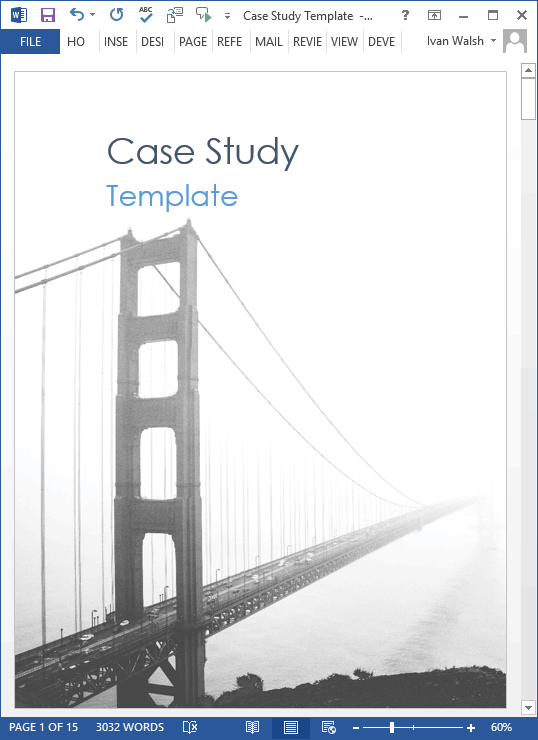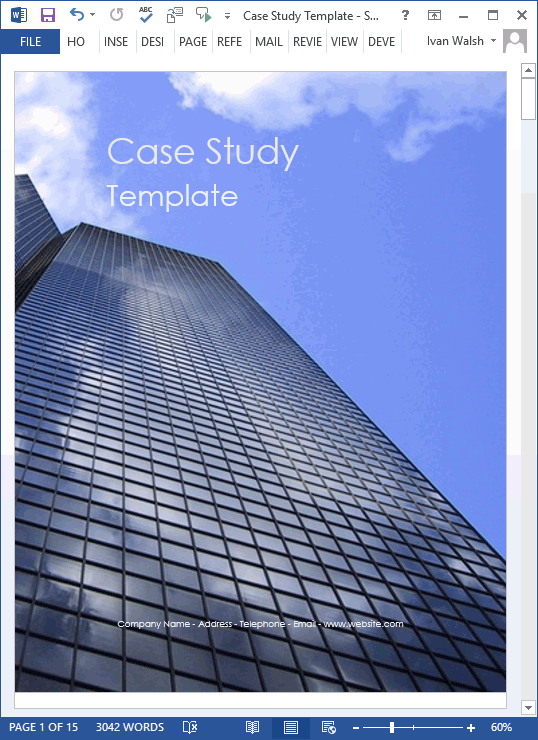Case Study Templates
How to Structure a Business Case Study
In this tutorial, we describe how to structure a business case study, typically the type of document that will form part of a marketing effort.
Unlike other business documents, such as white papers, the structure of a case study is a little different. The difference is two-fold: one is that the sequence is not linear. You don’t start at the start and work forwards. I’ll explain why below. The second is that, to give your case study some credibility, you need to back it up with statistics, metrics, KPIs you’ve reached etc — without these the case study falls flat.
Ok, let’s start.
[Learn more about these templates]
Case Study Format
Make sure to follow this template when writing the case study as readers have come to expect this format.
When writing your case study:
- Explain the outcome first, then
- Describe the situation before the project was started. What was the main problem, or set of issues, they were facing before your product or service was introduced?
- Outline the impact your product or service had. Here is where we need to give demonstrable proof that the implementation improved the previous situation. Without this, it’s hard for the reader to judge how effective the solution really is. Also, in terms of storytelling, without this success, the story ends on a flat note. Stats, figures, and numbers bring the case study to life.
- Close with the benefit your product/service had on the customer and their business. This is also where you can discuss their future plans, especially if it ties in with your implementation.
Case Study Structure
Typically, most business documents are presented in chronological order.
You start at the beginning and work forward.
However, with case studies, the sequence is different.
Why?
Because in case studies, the reader tends to:
- First check if the outcome applies to their situation.
- If it does, they’ll download and read it,
- Otherwise they’ll look elsewhere.
So, you need to start with the outcome, then work backwards towards how you got there.
The Role of Storytelling in Case Study Writing
What writing techniques should you use when writing a case study?
Consider storytelling.
By storytelling, we don’t mean Hans Andersen.
Rather, we mean that the narrative — the story you share with the reader — engages them in some way. It resonates with them.
- Can the reader see themselves in the other person’s position?
- Can the reader identify with the issues they were facing?
- How can you show the reader that the implementation delivered more than just a list of requirements and added demonstrable value?
- When is the reader likely to have the same issues as your customer?
- Where does the reader have the same dilemmas when selecting a vendor?
This is where you should consider using storytelling techniques.
In a marketing context, case studies, if written correctly, serve as a type of storytelling.
This means you need to create a ‘story’, one that the reader can relate to, rather than simply listing features.
Story telling devices allows us to discuss our product in such a way that it affects the reader and encourages them to learn more about the product.
How do you define storytelling?
Gartner defines storytelling in this context as:
- Using facts and provable statements to generate interest
- Establishing context
- Conveying emotion
- Closing with a positive outcome
The standard storytelling structure follows the following flow:
Step 1: Open with the outcome
The first step is to describe the final result.
What was the outcome after they used the product?
Try to use real figures and data to demonstrate your point. For example, the percentage it increased productivity, lowered costs, or improved turnaround. Numbers gives credibility to your case study.
It demonstrates that you can quantify the effectiveness of your product.
Include the number/statistic/percentage in the heading and, if it works, include it the first paragraph.
“XYZ achieved a 79% increase in productivity in 21 day.”
“XYZ lowered customer support calls by 47% in 3 months.”
When it is not possible to quantify an outcome, spend time to craft the qualitative impact you achieved for your customer.
Step 2: Capture the current situation
Here we need to capture two things:
- Context — describe the business context and how your product/service applied to the customer.
- Challenges — outline the challenges, issues, risks facing the customer at that time.
Describing the situation before you implemented your solution helps orient the reader. It allows them to compare their circumstances (risks/issues/challenges) against your example.
It also creates an expectation that your solution will resolve these issues, encouraging them to continue reading.
Step 3: Describe the impact
Next, we describe the impact of the challenge — not your product.
- Challenge — describe the impact of the challenge on your customer.
- Cost — describe the potential cost if they had not acted.
Don’t limit yourself to financial loses only. Costs can include different things.
- Missed business opportunities
- Inability to scale operations to meet demand
- Time consuming manual activities
- Impact on customer satisfaction
Step 4: Show a resolution
After establishing the need, the next step is to position your product as the solution.
To do this, your story need to how you helped your customer to:
- Overcome their obstacles
- Achieve the objectives you highlighted in the opening section of the case study
Read more in the following tutorial.
Summary
As mentioned at the start, one of the main differences when writing case studies is to start with the outcome, then work towards how you achieved this.
The second recommendation is to qualify your success. This means that you find ways to demonstrate in quantifiable terms how your product or service made a difference.
As mentioned, there are three ways to do this:
- Increases in terms of profit, productivity, efficiency, and other such areas
- Decreases in costs, such as overheads, staff numbers, processing times, and other capital expenditures.
- Risks that your product now helps control, mitigate against, and ensures you are compliant with legislation, for example.
In the following tutorials, we’ll look at how to write a sample case study. This is part of a series of tutorials on how to write case studies. Sign up to the newsletter to make sure you don’t miss a lesson.

[Learn more about these templates]

